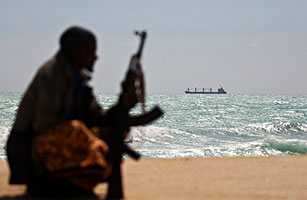
Correction appended April 28, 2010
This time last year, Somali pirates dominated headlines in the U.S. The hijacking of the Maersk Alabama, a tanker captained by an American, led to a made-for-Hollywood intervention by sharp-shooting Navy SEALS and triggered a media frenzy about the rise of piracy off the Horn of Africa. In the months that followed, a U.S.- and E.U.-led naval task force stepped up patrols around Somalia’s coastline and lessened the threat posed by pirates there. This year there were only 17 attacks in the Gulf of Aden and the waters surrounding Somalia between January and March — a peak time for piracy in the region because of favorable weather conditions — compared with more than 40 in that same period in 2009.
But Somalia’s pirates are far from defeated. On April 18, they pulled off one of their most ambitious captures yet, seizing three Thai fishing trawlers far out into the Indian Ocean. The vessels, which contained 77 crew members, were 1,200 miles away from the Somali coast — making the hijacking the farthest offshore heist ever conducted by Somali pirates as well as the largest in terms of numbers of hostages taken. Three days later, just four suspected Somali pirates armed with AK-47s and a rocket-propelled grenade managed to seize a Panamanian-listed bulk carrier 200 miles out from the Gulf of Aden corridor, which is still patrolled by convoys of international warships.
Despite the vigil of many of the world’s powerful navies, it’s clear that the pirates’ reach seems to be widening, with the majority of recent successful attacks taking place closer to the Indian Ocean archipelagoes of the Maldives and the Seychelles than Somalia. Currently, 15 vessels and 326 sailors are being held by Somali pirates — similar numbers to this time last year. Noel Choong, head of the International Maritime Bureau’s Piracy Reporting Center, based in Kuala Lumpur, says his organization has been receiving frantic calls from shipowners asking which Indian Ocean routes are safe. “It’s difficult to know what to tell them,” he says. “The pirates have been popping up almost everywhere.”
Analysts say the increasing range of the pirates is a tactical response to the foreign crackdown over stretches of sea closer to Somalia. Pirate captains “have learned the lessons of being hemmed in by these international navies,” says Roger Middleton, an expert on the Horn of Africa at Chatham House, a London-based think tank. “They’re probably thinking, The further away we go, the more scattered we are, the harder it is for the foreign navies to catch us.” At the peak of the patrols, there are between 35 and 40 warships plying the waters off Somalia and safeguarding commercial vessels transiting through the Gulf of Aden. Given that Somalia’s 1,900-mile coastline is continental Africa’s longest, there are plenty of holes for pirate “motherships” — retrofitted fishing vessels that tow along smaller skiffs and often carry large reserves of fuel as well as GPS equipment — to putter into the deep sea of the Indian Ocean. Middleton estimates that it would take a mammoth flotilla of 700 or 800 ships in the region to actually neutralize the full, albeit rudimentary, capabilities of the pirates.